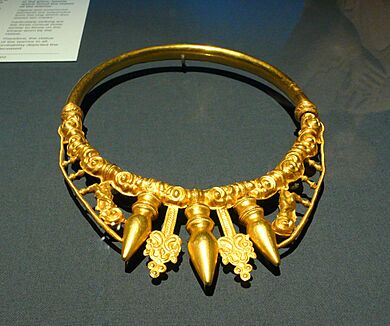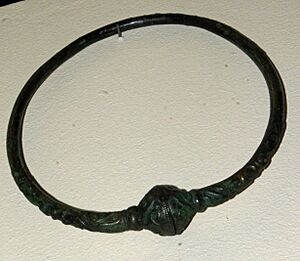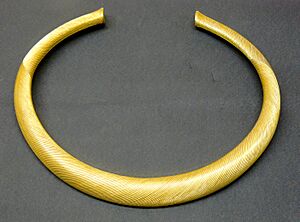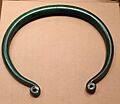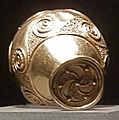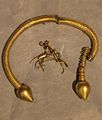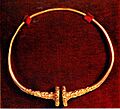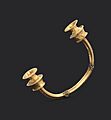Torc facts for kids
A torc (also spelled torq or torque) is a special kind of neck ring made from metal. It's usually very stiff and can be a single piece or made from twisted metal strands. Most torcs open at the front, but some have hooks or special locks to close them. Many were probably worn all the time because they were hard to take off.
People in ancient cultures like the Scythians, Illyrians, Thracians, and Celts wore torcs. These were popular in Europe during the European Iron Age, from about 800 BC to 300 AD. For the Iron Age Celts, a gold torc was very important. It showed that the person wearing it was of high rank. Until about 300 BC, women often wore them, but after that, men did. Many beautiful pieces of ancient Celtic art are torcs. Torcs became less common after the Iron Age, but similar metal necklaces, especially in silver, became popular again during the Viking Age.
Contents
What is a Torc?
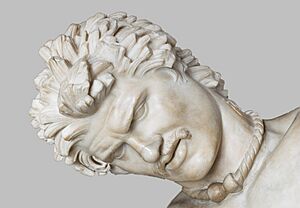
The word "torc" comes from the Latin word torquis, which means "to twist." This is because many torcs have a twisted shape. Neck-rings that open at the front are usually called "torcs." Those that open at the back are called "collars." Smaller versions, like bracelets or armlets, were worn on the wrist or upper arm and looked very similar.
Torcs were made from single metal rods, or from several "ropes" of twisted wire. Most torcs found by archaeologists are made of gold or bronze. Sometimes, they are made of silver, iron, or other metals. Gold, bronze, and silver last a long time when buried, which is why we find more of them.
Some fancy torcs were hollow and made using different methods. Complex designs often started with casting (pouring melted metal into a mold) and then were shaped further. The Ipswich Hoard has unfinished torcs that show how they were made step-by-step. The flat ends of some torcs are called "buffers."
Ancient Torcs in Europe and the East

Many types of stiff gold and bronze necklaces from the later European Bronze Age (around 1200 BC) are called "torcs." Many of these were twisted in different ways. For example, the "twisted ribbon" type was a thin strip of gold twisted into a spiral. Other torcs used a bar with a square shape or just a round wire.
Some of these Bronze Age "torcs" are too small for an adult's neck. They might have been worn as bracelets, armlets, or by children or statues. It can be hard for archaeologists to figure out exactly when some torcs were made. Some believe torcs were passed down through families for hundreds of years.
In the East, torcs also appeared in Scythian art from the Early Iron Age. These often had designs influenced by Eastern styles. Torcs are also found in Thraco-Cimmerian art. Some thin torcs from the Persian Achaemenid Empire often had animal heads at the ends.
Celtic Torcs and Their Meaning
Ancient pictures of Celtic gods and goddesses sometimes show them wearing or holding torcs. For example, the god Cernunnos is shown with a torc around his neck, and others hanging from his antlers. This might mean that the god was a source of power and wealth. The torc was a clear sign of being noble and having high social status.
The famous Roman statue The Dying Gaul shows a wounded Celtic warrior wearing a torc. This matches how ancient writers described Celtic warriors. One of the earliest images of a torc is on the Warrior of Hirschlanden statue (from the 6th century BC). Many of the few Celtic statues of people, mostly men, show them wearing torcs.
Torcs might have had other uses too. Some have stones or metal pieces inside, so they might have been used as rattles in rituals. Some torcs are too heavy to wear for a long time. These might have been made to be placed on statues of gods. Torcs were clearly valuable. They are often found broken into pieces, which suggests they were also used as a way to store wealth.
Torcs were "the most important type of Celtic gold jewelry." They were found with bracelets, armlets, and anklets. Early Celtic torcs are often found buried with women. For example, a gold torc was found in the grave of a princess in Germany. Other torcs were found in women's graves in France and Switzerland. Some experts think torcs were mainly for women until the late 3rd century BC. After that, they became a symbol for warriors. However, there is also evidence that men wore them earlier.
Many torcs have been found in groups, often with other valuable items, but not in graves. These were likely placed there on purpose. They might have been offerings in rituals or hidden for safety during wars. Some might have been unfinished pieces from a workshop. Later, torcs were especially common in Celtic cultures near the Atlantic coast, from Spain to Ireland, and around the English Channel.
Some very detailed torcs with carved designs have been found in Britain and Ireland. These date from about the 3rd to 1st centuries BC. The most famous English example is the Snettisham Torc (illustrated), found in Norfolk, England. It is made of electrum (a mix of gold and silver) and weighs a kilogram. The Broighter Gold hoard in Ireland contains a beautiful hollow torc with designs all around it. In 2009, four gold torcs were found in the Stirling Hoard in Scotland.

The Roman general Titus Manlius got his nickname "Torquatus" (meaning "the one who wears a torc") because he took a torc from a Gaulish warrior he defeated in 361 BC. After this, Romans started using torcs as awards for brave soldiers and special army units. Ancient writers mention that Romans found many torcs from defeated Celts after battles.
It's not clear if the "Warrior of Vacheres" statue, a Roman soldier, wears a torc as part of his uniform or because of his Celtic background. The Roman writer Quintilian said that the Emperor Augustus was given a gold torc by the Gauls that weighed about 33 kilograms. This would have been far too heavy to wear! A torc from the Winchester Hoard looks Celtic but uses a Roman gold-working technique. This suggests it might have been a "diplomatic gift" from a Roman to a British tribal king.
A very late example of a torc used as a special item in early Medieval Wales is mentioned by Gerald of Wales. He wrote about a royal torc called "Saint Kynauc's Collar" that belonged to Prince Cynog ap Brychan (around 492 AD). Gerald saw this torc in 1188 and described it as looking like gold, made of four joined pieces, with a dog's head. People believed it was so powerful that no one dared to lie when it was near. This torc is now lost. It's possible this torc was much older than Prince Cynog and was reused as a symbol of royal power.
Torcs are also mentioned in old Irish mythology. For example, in the Lebor Gabála Érenn (from the 11th century), it says that the god Elatha wore five golden torcs.
Romano-British Beaded Torcs

After the Roman conquest of Britain (around 75 AD), a different type of torc appeared, called the "beaded torc." These were mostly found in the northern parts of Roman Britain. They were made of copper alloy, not precious metals, and were likely worn by more ordinary people than the fancy Celtic torcs.
Torc Shapes and Designs
Most torcs from the Achaemenid Empire were thin, round bars with matching animal heads at the ends, facing each other. Some early Celtic torcs were different because they didn't have a break at the front. Instead, they were heavily decorated there, sometimes with animal shapes or rows of rounded bumps called "balusters."
Later Celtic torcs almost always had a break at the front and strong, noticeable ends. The Vix torc has two beautifully made winged horses near its ends. Like other fancy Celtic pieces, its design shows Greek influence, but it's not in a classical Greek style. It might have been made by Greeks for Celtic customers, or by Celts who learned from foreign artists.
Spiral ribbon torcs, which usually have simple ends, are a type that continued from the Bronze Age. They are found in places like the Stirling Hoard in Scotland. These simple, flexible torcs were popular for over 1,000 years. Their ends were often slightly flared cylinders that could be hooked together to fasten the torc. Other Celtic torcs used different ways to form the main hoop: plain bars, two or more bars twisted together, thin rods wrapped around a core, or woven gold wire.
The ends of Iron Age torcs were usually made separately. The "buffer" shape was very popular in France and Germany. In these types, the decoration often continued around the hoop. In torcs from Spain, thin gold bars were often wrapped around a core of cheaper metal.
About 150 torcs found in Galicia, Spain, often had ends shaped like pointed balls or a double-curved shape called scotiae. The pointed ball shape is also found in northern Italy. In British torcs, loops or rings are common at the ends. The main hoop might be two or more round bars twisted together, or several strands of twisted wire. The designs on the ends of the best British torcs are complex but abstract. The main hoop usually has no extra decoration, except for the large torc in the Irish Broighter Gold hoard, which is decorated all around.
Gallery
-
An Achaemenid torc from Persia, around 350 BC, with ribbed hoop and animal head ends.
-
The four Leekfrith torcs, the oldest gold torcs found in Great Britain, from about 400–250 BC.
-
The Torques de Foxados: a torc from Gallaecia with double "scotia" ends and a woven design.
-
A "bell shaped" torc end from A Guarda, Galicia.
-
A twisted ribbon torc from the Stirling Hoard, found in both the Bronze and Iron Ages.
-
The Snettisham Hoard, possibly a goldsmith's collection, showing different British torc styles, around 75 BC.
-
Two looped torcs from the Ipswich Hoard in East Anglia.
-
Looped torcs from the Snettisham Hoard in East Anglia.
-
A large silver torc from the Cordoba Treasure in the British Museum.
-
A fancy Iron Age neck collar from Lochar Moss in Dumfrieshire, Scotland.
-
A Celtic gold torc found in a Gaulish burial site in Marche, Italy.
-
A Gallic Gold Torque, in the Musée d'Aquitaine, Bordeaux.
See also
- Sedgeford Torc
- Leekfrith torcs
- Gold working in the Bronze Age British Isles
- List of Bronze Age hoards in Britain
- List of Iron Age hoards in Great Britain
- Manilla (money)
- Kalabubu, a torc from the Nias people made of coconut shell
- Bangle, a similar item but worn about the wrist



